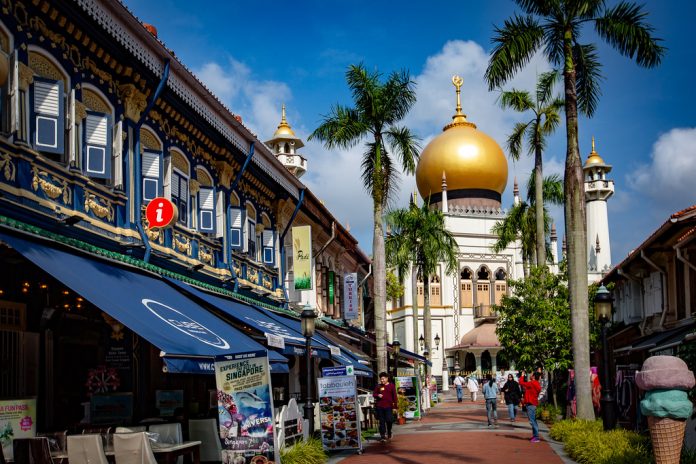The Sultan Mosque is located in the neighborhood that, in 1819, was assigned to the Malay Sultan of Johor who ruled Singapore. The original Masjid that stood on this site was constructed in 1824. To some extent funded by the East India Company, it was the style of Masjid typically found in Southeast Asia, with a low, two-tiered roof like a pyramid. However, a century later, the old Masjid had fallen into a state of disrepair and was replaced. Swan & Maclaren, the local architects in charge of many landmark buildings, designed it.
The Central Prayer Hall – The beautiful carpeted central prayer hall is big enough to accommodate 5,000 individuals. Thus, the main hall is for men only, while women occupy the galleries above. The carpet, donated by a Saudi Arabian prince, bears his emblem.

Mihrab – The Mihrab is a small niche that marks the direction of Makkah and it is from where the imam leads the congregation in prayer five times a day. This altar is decorated with intricately patterned gold motifs.
The Mimber – On Fridays, the Muslim holy day, the imam delivers his sermon, or khutbah, to a full prayer hall. He does so from the mimber, an elaborate pulpit atop a staircase reserved for the purpose.
Ramadan – After sunset during Ramadan, the month of fasting, the streets around the mosque are filled with stalls and stores selling appetizing Malay treats. Muslims break the fast with dates; take a sip of Turkish or Malay-style tea or fresh lime juice in the cafés along Bussorah Street, opposite the Masjid.
The Bottle Band – Around the base of the main onion dome is an unusual architectural feature. This is a wide black band made from rows of bottles stacked on their sides, five or six bottles high. Their bottoms appear to glisten like black and brown jewels in the sun.
The Maqam – At the rear of the Masjid is a maqam, or mausoleum, containing the graves of more than a few members of the Royal Family, including the grandson of Sultan Hussein, who signed over Singapore to Sir Stamford Raffles in 1819.
Mosque Alignment – Most Masjid is built with a prayer hall facing the holy city of Makkah. For this reason, North Bridge Road has a distinct bend to allow for the correct alignment of the Sultan Mosque.
The Domes – A tradition in Masjid architecture, the onion dome originates from Turkey and the Middle East. It creates a roofline distinguishable above the city’s low-rise buildings. At the top of each of the gold, domes stand the star and crescent – a traditional symbol of Islam.
Ablutions – Two areas have faucets, for worshipers to wash their hands, faces, and feet before prayers. These ablutions or wudhu is actually meaning to purify the body and soul.
Architectural Design – The Sultan Mosque is built in Saracenic style, combining Persian, Moorish, and Turkish designs including pointed arches, minarets, and domes. The interior is adorned with calligraphic verses and mosaics.
The Annex Mosques serve many purposes for Muslims – providing space for education, religious rituals, and community development programs. The annex at the Sultan Mosque, built in 1993, offers these services to the local Muslim community.
Related Reading – Faisal Masjid – The Master Piece of Architecture










